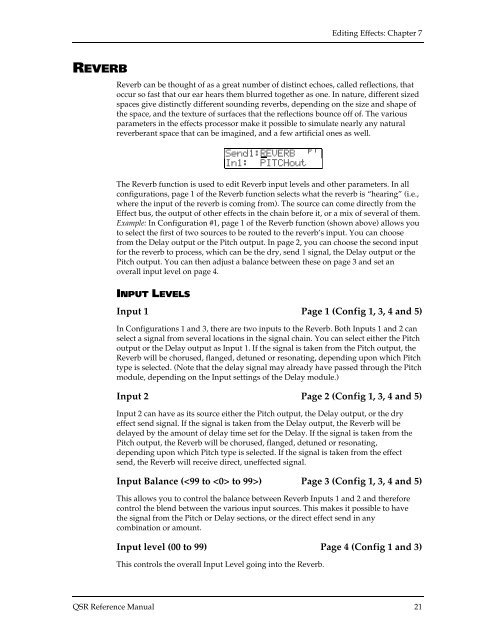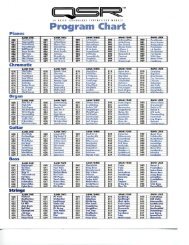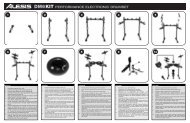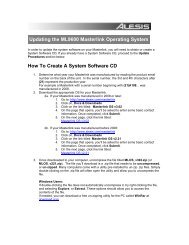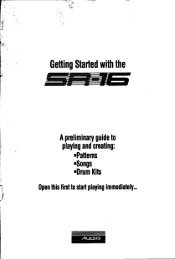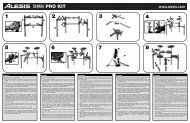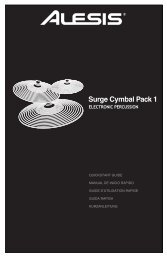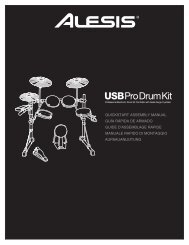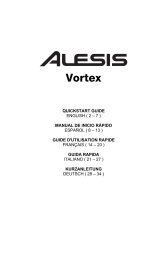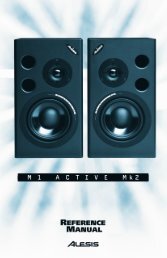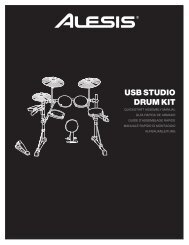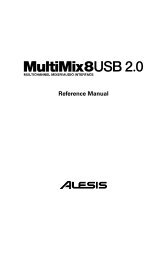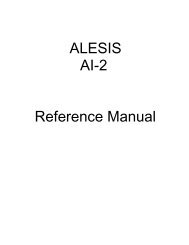QSR Reference Manual - Alesis
QSR Reference Manual - Alesis
QSR Reference Manual - Alesis
- No tags were found...
Create successful ePaper yourself
Turn your PDF publications into a flip-book with our unique Google optimized e-Paper software.
Editing Effects: Chapter 7REVERBReverb can be thought of as a great number of distinct echoes, called reflections, thatoccur so fast that our ear hears them blurred together as one. In nature, different sizedspaces give distinctly different sounding reverbs, depending on the size and shape ofthe space, and the texture of surfaces that the reflections bounce off of. The variousparameters in the effects processor make it possible to simulate nearly any naturalreverberant space that can be imagined, and a few artificial ones as well.Send1: REVERB πåIn1: PITCHoutThe Reverb function is used to edit Reverb input levels and other parameters. In allconfigurations, page 1 of the Reverb function selects what the reverb is “hearing” (i.e.,where the input of the reverb is coming from). The source can come directly from theEffect bus, the output of other effects in the chain before it, or a mix of several of them.Example: In Configuration #1, page 1 of the Reverb function (shown above) allows youto select the first of two sources to be routed to the reverb’s input. You can choosefrom the Delay output or the Pitch output. In page 2, you can choose the second inputfor the reverb to process, which can be the dry, send 1 signal, the Delay output or thePitch output. You can then adjust a balance between these on page 3 and set anoverall input level on page 4.INPUT LEVELSInput 1 Page 1 (Config 1, 3, 4 and 5)In Configurations 1 and 3, there are two inputs to the Reverb. Both Inputs 1 and 2 canselect a signal from several locations in the signal chain. You can select either the Pitchoutput or the Delay output as Input 1. If the signal is taken from the Pitch output, theReverb will be chorused, flanged, detuned or resonating, depending upon which Pitchtype is selected. (Note that the delay signal may already have passed through the Pitchmodule, depending on the Input settings of the Delay module.)Input 2 Page 2 (Config 1, 3, 4 and 5)Input 2 can have as its source either the Pitch output, the Delay output, or the dryeffect send signal. If the signal is taken from the Delay output, the Reverb will bedelayed by the amount of delay time set for the Delay. If the signal is taken from thePitch output, the Reverb will be chorused, flanged, detuned or resonating,depending upon which Pitch type is selected. If the signal is taken from the effectsend, the Reverb will receive direct, uneffected signal.Input Balance () Page 3 (Config 1, 3, 4 and 5)This allows you to control the balance between Reverb Inputs 1 and 2 and thereforecontrol the blend between the various input sources. This makes it possible to havethe signal from the Pitch or Delay sections, or the direct effect send in anycombination or amount.Input level (00 to 99) Page 4 (Config 1 and 3)This controls the overall Input Level going into the Reverb.<strong>QSR</strong> <strong>Reference</strong> <strong>Manual</strong> 21


